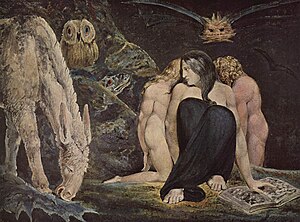The Night of Enitharmon's Joy
| Hecate, or The Night of Enitharmon's Joy | |
|---|---|
 |
|
| Artist | William Blake |
| Year | 1795 |
| Type | Pen and ink with watercolour on paper |
| Dimensions | 44 cm × 58 cm (17.32 in × 22.83 in) |
| Location | Tate Gallery, London |
The Night of Enitharmon's Joy, often referred as The Triple Hecate or simply Hecate, is a 1795 work of art by the English artist and poet William Blake which depicts Enitharmon, a female character in his mythology, or Hecate, a chthonic Greco-Roman goddess of magic and the underworld. The work presents a nightmarish scene with fantastic creatures.
The Triple Hecate is painted with deep tones and bold masses. Blake employed a new technique whose "effect is darker and richer than [his] illuminated books". One scholar interprets his colour print Hecate thus:
"She is triple, according to mythology: a girl and a boy hide their heads behind her back. Her left hand lies on a book of magic; her left foot is extended. She is attended by a thistle-eating ass, the mournful owl of false wisdom, the head of a crocodile (blood-thirsty hypocrisy), and a cat-headed bat."
Blake often drew on Michelangelo to create and compose his epic images, including Hecate's, according to a consensus of critics. "Blake is indebted to Michelangelo for many of his giant forms". Michelangelo contributed many "characters to Blake's gallery of mythic persons and heroes". Regarding the Hecate colour print, a suggested trail may be traced. From Michelangelo, Blake copied his early sketch entitled The Reposing Traveller, which then evolved into a figure for his work (1795-1797) regarding Night Thoughts, and also into the similarly posed figure of Hecate here.
The image may also allude to the Three Fates — the Moirai of Greek mythology and the Parcae of Roman. Notwithstanding these allusions, critics point out that a contemporary trigger for Blake's inspiration probably was the return popularity of Shakespeare's play Macbeth. As Hecate listens offstage, the three witches, in arranging Macbeth's doom, chant: "Double, double, toil and trouble; Fire burn and cauldron bubble". Each witch in turn adds her verses, the second's being:
...
Wikipedia
